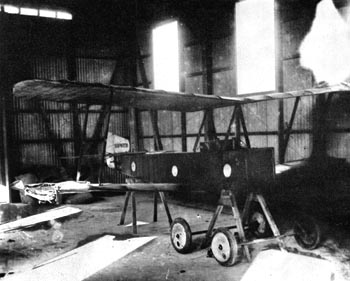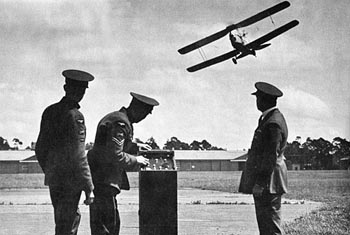
The 'Aerial Target' and 'Aerial Torpedo' in Britain
Aerial Torpedo. The Aerial Torpedo was introduced in the 1909 film The Airship Destroyer. An unknown country arms their zeppelins with bombs and launches an air raid on England. After a bombing raid British aircraft engage the zeppelins but are shot down. The bombing raid continues until finally a patriotic British inventor creates an "aerial torpedo," controlled by "wireless electricity," which he uses to bring down the enemy air fleet.
Airship Destroyer, The (Silent, England, 1909) July 28, 1914 http://rwebs.net/dispatch/output.asp?ArticleID=27 On July 28, 1914, the first aerial torpedo was launched from a Royal Navy Short seaplane by Lt. A. M. Longmore. The U. S. Navy first experimented with aerial torpedoes in late 1917, when a 400-pound dummy torpedo was dropped from a seaplane and ricocheted back into the air, almost hitting the plane. Since the aircraft of the day could lift only about 600 pounds of bombs or other ordnance, and the normal shipboard or submarine torpedo weighed 1,500 pounds or more, the torpedo bomber was not yet a reality.
Professor A.M. Low and the 'Aerial Target' Prior to World War One there was one man in England who was working on a brand new concept, radar. It also seems that somebody at the War Office felt that too many of England's best and brightest pilots were being killed by the Fokker Mono Plane (Eindecker) Scourge. The man who was to head up this new research project was a Professor A.M. Low.
 Sopwith AT download a 1000pixel image
At the start of W.W.I Professor Low was actually working on the very first electronic range finder, based on the principles of radar, for the Artillery Corps but the RFC (Royal Flying Corps) had other things in mind for the good Professor. The RFC wanted Prof. Low to put his knowledge of radar to use in designing and developing remotely controlled pilot-less aircraft. The concept was to develop a small, very simple aircraft. Pack it with explosives and then guide it into a designated target. Thus the RFC Experimental Works were born and the newly commissioned Second Lieutenant Low began his secret work in a Chiswick garage. As it turns out the aircraft design was the least of the challenges; it was the radio gear that needed to be developed first. As Low made progress with the radio gear there was a need to relocate the operation to a more aeronautical site and Brooklands was chosen. It was here that it was discovered that the uncowled 50 hp Gnome rotary engine caused so much radio noise as to make the operation of the gear unreliable (sound familiar). In spite of the engine noise and unreliability of the aircraft it was shipped off to the Central Flying School at Upavon. It was subsequently never flown. The key here is that the radio gear did operate as planned when the power plant was not running. As a matter of fact this remotely piloted vehicle (RPV) concept caught the interest of the great Sopwith Co. as well as Ruston Proctor & Co. Ltd who began immediate, parallel development to Low's own at the RFC. Granville Bradshaw of A.B.C. Motors Ltd. who gained fame by designing the well proven 45 hp Gnat engine subsequently designed a throwaway engine specifically for use in the RPV. The 35 hp was a horizontally-opposed twin cylinder engine with a run life of 2 hours. It was this lightweight inexpensive engine that propelled RPV research and development into the next phase. In the mean time Sopwith had developed the 14ft wingspan "Sopwith AT" (AT = air target) which was fitted with the 35 hp ABC engine driving an ordinary wooden propeller. The radio box was further back towards the tail behind the fuel, batteries and of course the explosives. The sensitive radio equipment was fitted into a wooden box with a glass lid, suspended on rubber supports. The box itself measured about 2ft 3in by 9in. This box contained all of the relays, receiver and the Key system which was an interference filter. An interesting note here, a shaft which was driven by the engine triggered a mechanical relay so that each contact made in the control box caused the engine power to operate the control services. The date was 1916 and the Sopwith AT was completed with full servo control. It never flew because it was subsequently damaged while in hangar and abandoned (sound familiar?). The ironic end result was the creation of the Sopwith Sparrow which was a small, single seat aircraft which did in fact have a pilot after all. Naturally this is not the end of our story, enter Geoffrey de Havilland. De Havilland built a little mono plane around the lightweight ABC expendable engine. It is believed that it was the de Havilland monoplane which flew on a March 21st, 1917 test flight at Upavon. The rumor is that high ranking officials were invited to attend and were quickly dispersed in a rather comical fashion when the initial test flight went awry as they so often do. No more is known. Later that year H.P. Folland the designer of the S.E.5 fighter embarked on task to build an aircraft using Low's radio equipment. By July of 1917 he had 5 aircraft ready for flight and on July 6, 1917 the first flight was conducted. The aircraft rolled smoothly along on a 150 ft launch track and became airborne mid way. The craft rose steeply, stalled and plummeted to the ground (sound familiar?). Two more tests were conducted on July 25 and 28 but the aircraft were under controlled and the entire "R/C" program slowed to a trickle until the end of the war. Late in the War there was some research and development in the U.S. but it was relegated to gyroscopically controlled flying bombs and as such do not merit discussion here. It wouldn't be until September 3rd, 1924 when we would see the very first successful radio control flight of a lighter than air craft. From the decks of H.M.S. Stronghold a 23 ft wings span craft designated the RAE Target made a fully controlled 12 minute flight. The only reason why the flight ended was because the engine stopped (sound familiar ?). Success at last! Subsequent flights off of the Stronghold were proving the viability of the notion of Radio Controlled flight. In fact the duration of the 10th flight was 39 minutes long. The flight was so successful that the RAE recorded a record 43 separate commands. Once the news of this reached the powers that be the RAE was given the go ahead to do what comes naturally...build it bigger and better with a larger pay load. Thus the LARYNX was born. This mid- winged mono plane was designed to hold 250lbs of high powered explosives and travel a distance of over 300 miles. The Armstrong Siddeley Lynx - 200 hp engines was enclosed in a low drag cowling at the front end of a light weight tubular fuselage and attained the impressive speed of over 190 mph in the year - 1927. This aircraft was years ahead of its kind and was even faster than its contemporary, manned, fighter planes. When it came time to actually replace the empty payload section with the intended explosives and field test the "flying bombs" they decided to forgo the R/C and install gyroscopes. They sent these aircraft to Iran where all of them failed miserably except one. This aircraft sailed off into the distance never to be seen or heard from again (sound familiar?). Whether the payload exploded or not, no one will ever know.
De Havilland Tiger Moth, Two seater bi plane trainer of the Royal Air Force, Maximum speed 109 mph, Ceiling 14,000 feet, and can remain airborne for three hours. The Royal Air Force last Bi Plane, which served as a trainer from 1932 to 1947.
 Remote piloting a Queen Bee download a 1000pixel image
Its design remained nearly the same throughout its history, and was well constructed and able to do aerobatics. A total of 8800 Tiger Moths were built which included 420 Radio Controlled Pilotless Target aircraft. (The Queen Bee) for the Royal Air Force. It was also used for a short period during the first months of world war two for coastal reconnaissance.
In the beginning of 1930, Kálmán Tihanyi moved to London at the invitation of the British Air Ministry to build a prototype of his aerial torpedo, whose plans he had completed in Berlin. Later that same year, he learned of RCA's interest in his television patents. While working on the aerial torpedo and negotiating with RCA, he conducted negotiations regarding various other inventions as well: wide-screen and stereo film, a reflector for submarines, etc. At the end of 1931, Tihanyi was invited by the Italian Navy to develop his torpedo for marine use. During the next three years, he divided his time between the laboratories of the Air Ministry in London and the laboratories of the Italian Navy off the harbor of Genoa, on Isola Castagna. also... In an article, entitled, "Etwas uber das Fernsehen," ("About television,") written by Kálmán Tihanyi and published in the journal: Funk und Fernseh Technik, Berlin, (undated, but judging form reference to the invitation by the British Air Ministry to London, probably in early 1930) Tihanyi describes his Aerial Torpedo as a device which also possesses "eyes" with the help of which it "sees" and locks onto moving targets deploying one of various weapons it carries for the target's destruction. It should be noted that the patent [K. Tihanyi: Br. Pat. 352,035/December 21, 1929 application, (conv. date December 16, 1929, Hungary), issued June 22, 1931.] describes television guidance through specially constructed light and heat sensitive photocells for other types of weaponry, such as tanks, bombs, etc. as well.
|
© Copyright 1999-2002 CTIE - All Rights Reserved - Caution |